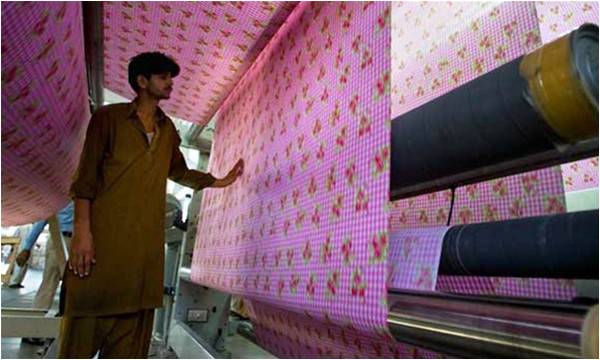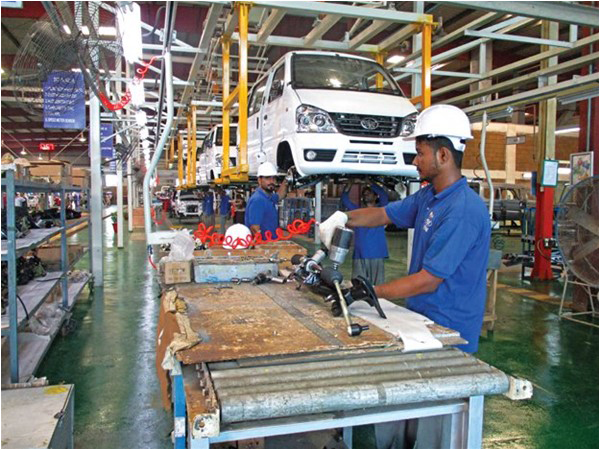
The Pakistan Business Council hosted the fourth session of the Pakistan Economic Forum in Islamabad mid-January, to highlight key issues manufacturers face. It pushed the “Make in Pakistan” message, which, as the title suggests, emphasizes the need to revive manufacturing in the country.
Is de-industrialization happening in Pakistan? We can define it in two ways. First, in terms of the sector’s total value addition decreasing, and secondly in terms of how much it is contributing to GDP, and whether this proportion is going up or down. In terms of the first measure, value added in the manufacturing sector has been increasing over time, even in terms of constant prices of 2005-06 as reported by the State Bank. Growth rates for large-scale manufacturing hover around 3% per annum, while those for small-scale manufacturing are estimated at just over 8%. And therein lies the problem.
Growth rates for large-scale manufacturing are as reliable or otherwise than other GDP data in Pakistan. As per the Pakistan Bureau of Statistics, the data is collected for establishments registered under the Factories Act of 1934, and the figures are published either in the Census of Manufacturing Industries or the Quantum Index of Manufacturing. The Census of Manufacturing Industries was last conducted in 2005-06, but its data forms the basis for weights assigned to different industry clusters. And this data is then used to construct the Quantum Index of Manufacturing, for which production data is collected through the provincial bureaus of statistics, the Oil Companies Advisory Committee and the Ministry of Industries and Production. The process is imperfect, not least because the Quantum Index of Manufacturing only covers 100 items, but there is at least an attempt to collect data from registered entities who figure in the records, if for no other reason than they have to be taxed.
But for small-scale enterprises or SMEs, there is a whole different measure. How does one calculate value added or production figures for entities that operate in the informal economy for the most part? Estimates for them are supposed to be based on surveys, most notably the Small Scale and Household Manufacturing Industries survey which is supposed to take place every ten years. The last survey was conducted in 2005-06, and showed an average annual growth rate in the sector of just over 8% compared to the previous census ten years earlier. Since no other survey has taken place, the same growth rate continues to be used. The problem is that this survey is in any case quite unreliable, simply because it is extremely difficult to trace (often unregistered) small enterprises.

According to the State Bank data, large-scale manufacturing accounts for about 80% of the value added in manufacturing as a whole, while small-scale manufacturing accounts for 13%, and the rest is attributed to value added in the slaughtering industry. One could thus argue that the growth rate of small-scale manufacturing does not matter so much, as it won’t change the basic growth picture significantly. This is true if the estimates of value added in small-scale manufacturing are somewhat accurate. But as things stand, one cannot say with a degree of confidence that this is the case.
By the first measure of de-industrialization (an actual drop in manufacturing value added) one cannot say that Pakistan is de-industrializing based on the data available. But the data on which this presumption is based is rather unreliable—registered enterprises are likely to be misreporting, since there are inadequate institutional checks on data provided. And for unregistered enterprises, the data collection methodology is essentially a black hole.
To take the second measure of de-industrialization, one has to look at the share of manufacturing in GDP over a period of time and study trends. Since all GDP data is collected through similar approximations and assumptions, combined with surveys, this is a better measure of what is going on. As of 2017, manufacturing (large and small scale and slaughtering) constituted about 13.5% of GDP as per constant prices of 2005-06. And it has remained more or less stable at this level for the last five years or so. About fifteen years ago, manufacturing amounted to about 15% of GDP. More worrying, the share of manufacturing-based products in exports has also been falling.
On the face of it therefore, it would seem that a degree of de-industrialization has set in by this measure. And this is a cause for concern. Almost all developing countries who have successfully reduced poverty levels (and there are few of those in the world, China being the foremost recent example), have done so by developing manufacturing and training a workforce to handle production. And here we are including software development in manufacturing rather than services, given that software is a tradable product.
History suggests that it is only when manufacturing begins to yield dividends in terms of a boost to exports, and a trained workforce, that it becomes feasible for an economy to diversify into high-end services like finance or hi-tech communications. What has happened in Pakistan is that the economy seems to be moving from agriculture to low-end services, mainly retail and wholesale trade, which essentially do not require significant investment of capital or a skilled workforce. The problem is that the growth of such low-end services is restricted if purchasing power in the economy is limited. And purchasing power will not increase if the workforce is not trained to work in higher-value commodity producing sectors. Essentially, the commodity-producing sectors (both agriculture and manufacturing) have to generate enough of a surplus to sustain services.
The upshot of this is as follows. The data on manufacturing is sketchy and unreliable and must be updated to get a clearer picture of where Pakistan stands. But if current data is anything to go by, Pakistan has already suffered a degree of de-industrialization over the last decade or so and this trend is likely to continue into the longer term future. This does not bode well for sustainable growth and human development.
The writer is an independent researcher based in Islamabad.
Is de-industrialization happening in Pakistan? We can define it in two ways. First, in terms of the sector’s total value addition decreasing, and secondly in terms of how much it is contributing to GDP, and whether this proportion is going up or down. In terms of the first measure, value added in the manufacturing sector has been increasing over time, even in terms of constant prices of 2005-06 as reported by the State Bank. Growth rates for large-scale manufacturing hover around 3% per annum, while those for small-scale manufacturing are estimated at just over 8%. And therein lies the problem.
What has happened in Pakistan is that the economy seems to be moving from agriculture to low-end services
Growth rates for large-scale manufacturing are as reliable or otherwise than other GDP data in Pakistan. As per the Pakistan Bureau of Statistics, the data is collected for establishments registered under the Factories Act of 1934, and the figures are published either in the Census of Manufacturing Industries or the Quantum Index of Manufacturing. The Census of Manufacturing Industries was last conducted in 2005-06, but its data forms the basis for weights assigned to different industry clusters. And this data is then used to construct the Quantum Index of Manufacturing, for which production data is collected through the provincial bureaus of statistics, the Oil Companies Advisory Committee and the Ministry of Industries and Production. The process is imperfect, not least because the Quantum Index of Manufacturing only covers 100 items, but there is at least an attempt to collect data from registered entities who figure in the records, if for no other reason than they have to be taxed.
But for small-scale enterprises or SMEs, there is a whole different measure. How does one calculate value added or production figures for entities that operate in the informal economy for the most part? Estimates for them are supposed to be based on surveys, most notably the Small Scale and Household Manufacturing Industries survey which is supposed to take place every ten years. The last survey was conducted in 2005-06, and showed an average annual growth rate in the sector of just over 8% compared to the previous census ten years earlier. Since no other survey has taken place, the same growth rate continues to be used. The problem is that this survey is in any case quite unreliable, simply because it is extremely difficult to trace (often unregistered) small enterprises.

According to the State Bank data, large-scale manufacturing accounts for about 80% of the value added in manufacturing as a whole, while small-scale manufacturing accounts for 13%, and the rest is attributed to value added in the slaughtering industry. One could thus argue that the growth rate of small-scale manufacturing does not matter so much, as it won’t change the basic growth picture significantly. This is true if the estimates of value added in small-scale manufacturing are somewhat accurate. But as things stand, one cannot say with a degree of confidence that this is the case.
By the first measure of de-industrialization (an actual drop in manufacturing value added) one cannot say that Pakistan is de-industrializing based on the data available. But the data on which this presumption is based is rather unreliable—registered enterprises are likely to be misreporting, since there are inadequate institutional checks on data provided. And for unregistered enterprises, the data collection methodology is essentially a black hole.
To take the second measure of de-industrialization, one has to look at the share of manufacturing in GDP over a period of time and study trends. Since all GDP data is collected through similar approximations and assumptions, combined with surveys, this is a better measure of what is going on. As of 2017, manufacturing (large and small scale and slaughtering) constituted about 13.5% of GDP as per constant prices of 2005-06. And it has remained more or less stable at this level for the last five years or so. About fifteen years ago, manufacturing amounted to about 15% of GDP. More worrying, the share of manufacturing-based products in exports has also been falling.
On the face of it therefore, it would seem that a degree of de-industrialization has set in by this measure. And this is a cause for concern. Almost all developing countries who have successfully reduced poverty levels (and there are few of those in the world, China being the foremost recent example), have done so by developing manufacturing and training a workforce to handle production. And here we are including software development in manufacturing rather than services, given that software is a tradable product.
History suggests that it is only when manufacturing begins to yield dividends in terms of a boost to exports, and a trained workforce, that it becomes feasible for an economy to diversify into high-end services like finance or hi-tech communications. What has happened in Pakistan is that the economy seems to be moving from agriculture to low-end services, mainly retail and wholesale trade, which essentially do not require significant investment of capital or a skilled workforce. The problem is that the growth of such low-end services is restricted if purchasing power in the economy is limited. And purchasing power will not increase if the workforce is not trained to work in higher-value commodity producing sectors. Essentially, the commodity-producing sectors (both agriculture and manufacturing) have to generate enough of a surplus to sustain services.
The upshot of this is as follows. The data on manufacturing is sketchy and unreliable and must be updated to get a clearer picture of where Pakistan stands. But if current data is anything to go by, Pakistan has already suffered a degree of de-industrialization over the last decade or so and this trend is likely to continue into the longer term future. This does not bode well for sustainable growth and human development.
The writer is an independent researcher based in Islamabad.

